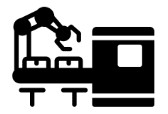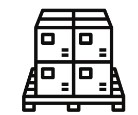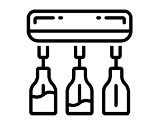Robotics play a crucial role in industrial automation as it can help improve productivity, increase efficiency, and reduce costs. By automating repetitive and dangerous tasks, such as assembly line work, robots can perform these tasks faster and with greater precision, resulting in higher quality products.
Industrial robots can be programmed to perform a variety of tasks, including material handling, welding, painting, and packaging. They can work around the clock without breaks or fatigue, resulting in increased production rates. Additionally, robots can be equipped with sensors and cameras to collect data and provide real-time feedback to operators, allowing for continuous improvement of the manufacturing process. Overall, robotics is a valuable tool in industrial automation that can help businesses stay competitive in today’s global market.
Contact us HERE for an audit of your application and customized ROI plan!
 MACHINE TENDING
MACHINE TENDING
Robotic machine tending is the automated process of loading of raw materials into the machine and unloading of finished parts out of the machine.
 MATERIAL REMOVAL
MATERIAL REMOVAL
Robots are used for cutting automotive headlining fabrics, trimming flash from plastic moldings, and polishing molds and stamping dies. Material removal is a helpful way to use robotic automation solutions to increase production, reduce stress and injury to your team and add long term ROI.
 PALLETIZING
PALLETIZING
Palletizing robots move units from the infeed conveyor to their stacking position according to the layer pattern. They can also be programmed to handle empty pallets and slip sheets. They constantly produce stable loads directly on the floor or conveyors for increased capacity and automation.
 ASSEMBLY
ASSEMBLY
Robotic assembly production often involves the task of forming or joining multiple parts together which can be a tedious job that requires precision and speed. The robot is integrated with end of arm tooling allowing it to perform the desired operation. The process can be automated using a single robot in which a human removes and replaces the item being assembled or having another robot remove and replace the part.
 MATERIAL HANDLING
MATERIAL HANDLING
Whenever technically and economically feasible, robotic equipment can be used to reduce and sometimes replace the need to manually handle material. Ongoing advances in sensing, machine intelligence, and robotics have made it possible to fully automate an increasing number of handling tasks.
 SPOT WELDING
SPOT WELDING
Robotic welding is a manufacturing process that uses mechanized programmable tools — which are also considered robots — for a completely automated welding process in which both the welding and the handling of the part are conducted by the robot.
 PAINTING
PAINTING
 ARC WELDING
ARC WELDING
A basic robotic arc welding system is formed by two subsystems: the welding equipment delivering the energy from the welding power source to the workpiece, and the robot providing relative positioning of the heat source and the workpiece.
 SEALING/DISPENSING
SEALING/DISPENSING
For robotic assembly applications involving dispensing and sealing, cobots (collaborative robots) are becoming the go-to solution. Dispensing and sealing robots allow for volumes and rates to vary widely, from small syringe applicators to large volume, dual-drum, automatic switchover units.
Contact us HERE for an audit of your application and customized ROI plan!
